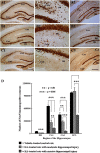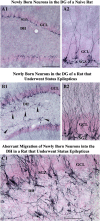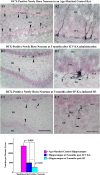Promise of resveratrol for easing status epilepticus and epilepsy
- PMID: 21554899
- PMCID: PMC3133838
- DOI: 10.1016/j.pharmthera.2011.04.008
Promise of resveratrol for easing status epilepticus and epilepsy
Abstract
Resveratrol (RESV; 3,5,4'-tri-hydroxy stilbene), a naturally occurring phytoalexin, is found at a high concentration in the skin of red grapes and red wine. RESV mediates a wide-range of biological activities, which comprise an increased life span, anti-ischemic, anti-cancer, antiviral, anti-aging and anti-inflammatory properties. Studies in several animal prototypes of brain injury suggest that RESV is an effective neuroprotective compound. Ability to enter the brain after a peripheral administration and no adverse effects on the brain or body are other features that are appealing for using this compound as a therapy for brain injury or neurodegenerative diseases. The goal of this review is to discuss the promise of RESV for treating acute seizures, preventing the acute seizure or status epilepticus induced development of chronic epilepsy, and easing the chronic epilepsy typified by spontaneous recurrent seizures and cognitive dysfunction. First, the various beneficial effects of RESV on the normal brain are discussed to provide a rationale for considering RESV treatment in the management of acute seizures and epilepsy. Next, the detrimental effects of acute seizures or status epilepticus on the hippocampus and the implications of post-status epilepticus changes in the hippocampus towards the occurrence of chronic epilepsy and cognitive dysfunction are summarized. The final segment evaluates studies that have used RESV as a neuroprotective compound against seizures, and proposes studies that are critically needed prior to the clinical application of RESV as a prophylaxis against the development of chronic epilepsy and cognitive dysfunction after an episode of status epilepticus or head injury.
Published by Elsevier Inc.
Figures










Similar articles
-
Resveratrol Treatment after Status Epilepticus Restrains Neurodegeneration and Abnormal Neurogenesis with Suppression of Oxidative Stress and Inflammation.Sci Rep. 2015 Dec 7;5:17807. doi: 10.1038/srep17807. Sci Rep. 2015. PMID: 26639668 Free PMC article.
-
Prospects of Cannabidiol for Easing Status Epilepticus-Induced Epileptogenesis and Related Comorbidities.Mol Neurobiol. 2018 Aug;55(8):6956-6964. doi: 10.1007/s12035-018-0898-y. Epub 2018 Jan 25. Mol Neurobiol. 2018. PMID: 29372545 Free PMC article. Review.
-
Resveratrol for Easing Status Epilepticus Induced Brain Injury, Inflammation, Epileptogenesis, and Cognitive and Memory Dysfunction-Are We There Yet?Front Neurol. 2017 Nov 13;8:603. doi: 10.3389/fneur.2017.00603. eCollection 2017. Front Neurol. 2017. PMID: 29180982 Free PMC article. Review.
-
Trans-resveratrol: a magical elixir of eternal youth?Curr Med Chem. 2008;15(19):1887-98. doi: 10.2174/092986708785132951. Curr Med Chem. 2008. PMID: 18691046 Review.
-
Resveratrol suppressed seizures by attenuating IL-1β, IL1-Ra, IL-6, and TNF-α in the hippocampus and cortex of kindled mice.Nutr Neurosci. 2017 Nov;20(9):497-504. doi: 10.1080/1028415X.2016.1189057. Epub 2016 Jun 2. Nutr Neurosci. 2017. PMID: 27256583
Cited by
-
Resveratrol has an Overall Neuroprotective Role in Ischemic Stroke: A Meta-Analysis in Rodents.Front Pharmacol. 2021 Dec 20;12:795409. doi: 10.3389/fphar.2021.795409. eCollection 2021. Front Pharmacol. 2021. PMID: 34987407 Free PMC article. Review.
-
The Neuroprotective Effect of Hericium erinaceus Extracts in Mouse Hippocampus after Pilocarpine-Induced Status Epilepticus.Int J Mol Sci. 2019 Feb 16;20(4):859. doi: 10.3390/ijms20040859. Int J Mol Sci. 2019. PMID: 30781501 Free PMC article.
-
Inflammation: A Network in the Pathogenesis of Status Epilepticus.Front Mol Neurosci. 2018 Oct 5;11:341. doi: 10.3389/fnmol.2018.00341. eCollection 2018. Front Mol Neurosci. 2018. PMID: 30344475 Free PMC article. Review.
-
Effects of adipose derived stem cells pretreated with resveratrol on sciatic nerve regeneration in rats.Sci Rep. 2023 Apr 10;13(1):5812. doi: 10.1038/s41598-023-32906-9. Sci Rep. 2023. PMID: 37037844 Free PMC article.
-
Resveratrol Treatment after Status Epilepticus Restrains Neurodegeneration and Abnormal Neurogenesis with Suppression of Oxidative Stress and Inflammation.Sci Rep. 2015 Dec 7;5:17807. doi: 10.1038/srep17807. Sci Rep. 2015. PMID: 26639668 Free PMC article.
References
-
- Abd El-Mohsen M, Bayele H, Kuhnle G, Gibson G, Debnam E, Kaila Srai S, et al. Distribution of [3 H]trans-resveratrol in rat tissues following oral administration. Br J Nutr. 2006;96:62–70. - PubMed
-
- Abrous DN, Koehl M, Le Moal M. Adult neurogenesis: From precursors to network and physiology. Physiol Rev. 2005;85:523–569. - PubMed
-
- Aimone JB, Wiles J, Gage FH. Potential role for adult neurogenesis in the encoding of time in new memories. Nat Neurosci. 2006;9:723–727. - PubMed
-
- Alessio A, Damasceno BP, Camargo CH, Kobayashi E, Guerreiro CA, Cendes F. Differences in memory performance and other clinical characteristics in patients with mesial temporal lobe epilepsy with and without hippocampal atrophy. Epilepsy Behav. 2004a;5:22–27. - PubMed
-
- Alessio A, Kobayashi E, Damasceno BP, Lopes-Cendes I, Cendes F. Evidence of memory impairment in asymptomatic individuals with hippocampal atrophy. Epilepsy Behav. 2004b;5:981–987. - PubMed
Publication types
MeSH terms
Substances
Grants and funding
LinkOut - more resources
Full Text Sources
Other Literature Sources
Medical

